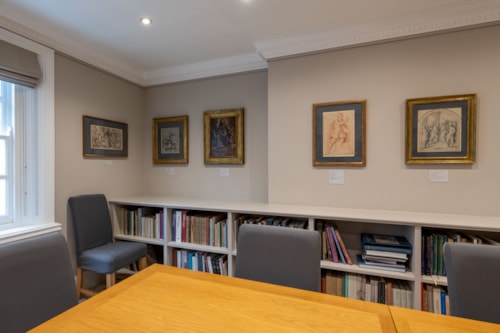Giovanni BALDUCCI
(Florence 1560 - Naples After 1631)
The Visitation [recto]; Sketch for The Visitation and a Design for its Frame and the Altar Chapel Facade [verso]
The verso in red chalk, pen and brown ink and blue wash.
336 x 271 mm. (13 1/4 x 10 5/8 in.) at greatest dimensions.
The verso of the present sheet contains a rapid sketch in red chalk of the composition of the Visitation on the recto, together with a rough design for the surrounding frame for the altarpiece, with its arched top. The verso also shows Balducci’s sketch for the decoration of the chapel façade in which his painting was to be placed, to be surmounted by a coat of arms - presumably that of the donor of the chapel or the altarpiece itself – flanked by spandrels with winged angels.
Musella Guida has likened the red chalk sketches on the verso of this sheet with another, albeit earlier drawing by Balducci in the collection of the Morgan Library; a study of The Angels Appearing to Abraham, which is likely to date from the artist’s Florentine or Roman period.
Among stylistically comparable drawings by Balducci is a study of The Calling of Saint Matthew, in the Giacomo and Nicola Giuliani Collection in Campobasso in southern Italy, and a drawing of The Holy Trinity Crowning the Virgin, in the Musée des Beaux-Arts in Dijon.
The begining of the next decade found the artist working at the cathedral in Volterra, where he painted a Miracle of the Loaves and Fishes for the Serguidi chapel. In 1594, together with his fellow painter Agostino Ciampelli, Balducci was summoned to Rome by Alessandro de’ Medici to contribute to the decoration of his titular church of Santa Prassede. During the next two years in Rome he painted altarpieces for the churches of San Giovanni Decollato, San Giovanni dei Fiorentini, San Giovanni in Laterano and San Gregorio al Celio. He also painted an apse fresco for the cathedral in Velletri, commissioned from him by Cardinal Alfonso Gesualdo and completed in 1595. Soon afterwards, in the spring of 1596, Balducci travelled to Naples, in the retinue of Cardinal Gesualdo, to work on the decoration of the Duomo. He was to work in Naples and Calabria for more than thirty years, receiving numerous commissions for paintings and frescoes, notably a now-lost fresco cycle for the Palazzo Reale. Among the churches where he worked in Naples were San Giovanni dei Fiorentini, Santissima Annunziata, Santa Maria de Monteverginella and, towards the end of his life, Santa Maria del Carmine. Balducci also designed a number of tapestries, known as the Giornata di Seminara, for the Neapolitan nobleman Vincenzo Luigi di Capua. However, very little of his Neapolitan work survives today, and this period of his career remains relatively little known in comparison with his work in Florence and Rome.
Balducci’s early drawings, sometimes on prepared or coloured paper, show the particular influence of his master Naldini. Although he had a fairly distinctive style as a draughtsman, and produced a fair number of autograph drawings, those of his later Neapolitan period are less well-studied. Relatively few drawings by the artist can be connected with finished paintings or frescoes, and therefore establishing a firm chronology of his style as a draughtsman remains a challenge. A small but interesting group of drawings by Balducci is today in the Musée des Beaux-Arts in Lille, while other examples are in the Hessisches Landesmuseum in Darmstadt, the National Gallery of Scotland in Edinburgh, the Uffizi and the Biblioteca Marucelliana in Florence, the Wadsworth Atheneum in Hartford, the British Museum and the Courtauld Institute Gallery in London, the Biblioteca Nacional and the Museo del Prado in Madrid, the Staatliche Graphische Sammlung in Munich, the Louvre in Paris, the Istituto Centrale per la Grafica in Rome, the Biblioteca Reale in Turin and elsewhere.
Provenance
Literature








